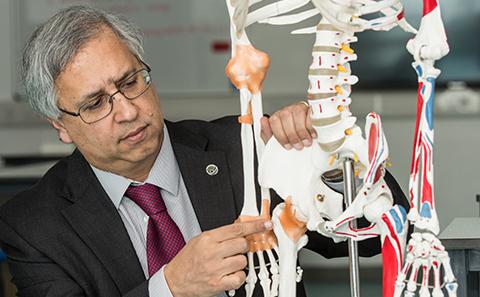Preventing disease in port cities
Analysing pollution particles from the docks to fight disease on the coast
Air pollution is a major threat to our health, as well as our planet. According to the World Health Organization, it kills an estimated seven million people worldwide every year. Southampton scientists are investigating how air pollution from port cities contributes to health issues.
“When it comes to air pollution, most attention focuses on cars and other motor vehicles, but we don’t know very much about ships and docks,” says Dr Matthew Loxham, BBSRC Future Leader Fellow in Respiratory Biology and Air Pollution Toxicology, and National Institute for Health Research (NIHR) Southampton Biomedical Research Centre Senior Research Fellow.
Our aim is to find out more about what emissions are produced from different activities at the docks, and how that might potentially affect our health.
Dr Matthew Loxham explains his research on port air pollution in the video below.
Airborne particles are strongly linked to heart disease and lung cancer; they are also associated with asthma, poor lung function and strokes. Poor air quality does not just kill, but can reduce quality of life, and with people living longer and urban areas expanding, there is the potential for long-term exposure to pollution to have profound health consequences.
Size matters
Matthew and his team have collected particles from six sites around the dock areas in Southampton, using a piece of precision-engineered equipment called a high-volume cascade impactor, which sucks in vast quantities of air – containing several billion particles per minute – and separates them into different sizes.
The particles the team is studying are between 10 and 1,000 times smaller than the width of a human hair (between 0.1 and 10 microns). They come from a range of sources, including from erosion from buildings, road vehicle exhausts, burning of fuels from ships, domestic heating, the wear of car brakes, and different gases reacting together in the air.
Final-year PhD student Natasha Easton is part of the team working on the project:
“For my PhD I am collecting samples of airborne particulate matter and determining their chemical composition. From this, we can work out what sources are contributing to our air pollution and by how much,” explains Natasha.
I’ve always been inquisitive and wanted to contribute to science in a way that made a difference. In this field I have a real opportunity to influence future policy, which is very satisfying.
Health effects
Depending on their size and shape, the particles can deposit at different points in our airways, causing varying health effects.
“The example I always use to explain this is asbestos. If I threw some flour up in the air, you probably wouldn’t mind too much, but if I threw asbestos, you wouldn’t want to stay in the room for very long. The difference is partly that asbestos is a very long, thin fibre that can reach into the depths of our lungs, and partly what it’s made of, both of which allow it to cause damage,” says Matthew.
“What I find really fascinating about this topic is the interaction between engineering, chemistry, our environment and our health,” he adds.
The team is now testing the particles they have collected in the laboratory to find out how the cells in our lungs might respond when we inhale them.
If they find potentially harmful particles, Matthew explains that rather than dramatically changing the logistics of how the city and docks work, small adaptations could be immediately helpful – for example, advising residents, particularly those with existing health conditions, to keep their windows closed on certain days when pollution is particularly high. Longer term improvements might, however, require more fundamental changes based on further research.
“There’s no quick fix. I don’t think pollution will ever be completely eradicated, but it’s about using science to understand what the effects on health are and how we can minimise those, and to improve people’s quality of life in an intelligent way, while reducing potentially disruptive effects to the economy and infrastructure,” says Matthew.
“Now that we are all spending more time indoors due to the coronavirus (COVID-19) pandemic, there is also a pressing need for research efforts to improve our understanding of how indoor pollutants – which may come from sources such as aerosol sprays, air fresheners and cooking – affect our health,” he adds.
Tips on reducing your exposure to air pollution
We asked Matthew for some tips on how we can minimise our exposure to air pollution in our everyday lives. Here are his suggestions.
- Avoid main roads if you can; use quieter back streets with less traffic.
- If you have to walk on a main road, try to walk on the side of the road with the least traffic.
- In busy traffic, the air quality has been shown to be worse inside a car than on the pavement, so walking or cycling may be better for your health, as well as the planet, while using public transport will help reduce emissions.
- Wood burning stoves are widely believed to be environmentally friendly, but this is not always the case, and there is evidence that some emissions from wood stoves may be harmful to our health.
Related Staff Member
You may also be interested in:

Tackling public health challenges
Instigating step changes in public health, both in the UK and internationally

Health impact of air pollution
According to a new report involving Southampton researchers, air pollution causes around 40,000 deaths and costs the UK economy £20bn every year.
